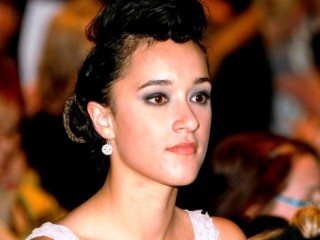
Keisha Castle-Hughes biography
Date of birth : 1990-03-24
Date of death : -
Birthplace : Donnybrook, Western Australia, Australia
Nationality : New Zealand
Category : Arts and Entertainment
Last modified : 2011-09-15
Credited as : actress, Whale Rider,
0 votes so far
Castle-Hughes was born in 1990 in Donnybrook, Western Australia. Her mother, Desrae Hughes, is of Maori heritage, while her father, Tim Castle, is Australian. Castle-Hughes and her two younger brothers moved to New Zealand with their mother when she was four years old, and settled in Mount Wellington, a suburb just outside of New Zealand's largest city, Auckland. She always dreamed of acting, Castle-Hughes recalled, but had never even appeared in a school play when a casting agent for a movie to be filmed on New Zealand's North Island arrived at her school. Diana Rowan, who had found a young Anna Paquin to play Holly Hunter's daughter in the acclaimed 1993 film, The Piano, felt that Castle-Hughes possessed the necessary blend of guilelessness and perseverance to take on what would prove to be a challenging role for any actress.
Just a few days after her formal audition for Whale Rider, Castle-Hughes took part in a career day event at her school, and hinted that she would like a career in the performing arts. "People were like, 'It's not going to happen. It's a great dream, but let's get real here,'" she recalled in an interview with Entertainment Weekly writer Sumeet Bal. In the end, Whale Rider 's director, Niki Caro, who also wrote the screenplay, agreed with Rowan and cast Castle-Hughes in the lead.
Whale Rider featured an entirely Maori cast. Castle-Hughes, her brothers, and mother moved to the fishing village of Whangara for the shoot, which was a homecoming of sorts, for her mother's family was originally from the area. Caro's screenplay was based on a book from the 1980s by Witi Ihimaera, a well known Maori writer, and recounted the story of a young girl who is the sole heir in her family to the tribal chief seat held by her grandfather. He refuses to acknowledge the possibility of a girl serving as the local leader, however, despite her increasingly obvious suitability for the challenges of the job.
Castle-Hughes played Paikea, nicknamed "Pai," a young woman given the controversial name by her artist father, who soon vanished to Europe. In Maori lore, the original Paikea was the male ancestor who came to Whangara from Polynesia a thousand years earlier on the back of a whale. Tradition among the Ngati Kanohi of Whangara, who are considered descendants of the first Paikea, holds that the firstborn son among Paikea's direct descendants should become chief. Pai is her grandfather's sole remaining progeny, however. Both a twin brother and her mother died in childbirth, and the orphaned girl lives with her prickly grandfather Koro (Rawiri Paratene) and his more supportive wife, Nanny Flowers (Vicky Haughton). Koro treats Pai with contempt, and announces his intention to begin searching for a new chief from among the boys in the village.
Secretly, Pai learns the customs and songs she needs to lead, and also trains in taiaha, the Maori stick fighting martial art permitted only for boys. When Koro tosses his whale tooth pendant into the sea the symbol of his authority it is Pai who finds it. In one moving movement, she delivers a speech at a school event, and dedicates it to Koro, but she realizes as she talks about her culture that her grandfather has not even bothered to show up. When a group of whales beaches in Whangara following a storm, villagers wonder who might lead them back out to sea, as their custom dictates. Pai takes the job and proves her mettle.
Castle-Hughes admitted that in the whale riding scene, it was a mechanical mammal she rode, but the sequence was filmed a mile out at sea. She also had a stunt double for part of the scenes, since she was not a strong enough swimmer yet for ocean currents. For all her other scenes, however, Castle-Hughes won enthusiastic praise from critics when Whale Rider was released in the United States in the summer of 2003. The New York Times film reviewer, Elvis Mitchell, described it as "wickedly absorbing. Much of the film's power comes from the delicate charisma of" its young star, and the critic added that though she appeared untrained as an actress, Castle-Hughes "instead communicates her feelings through a wary hesitation. It doesn't matter that her voice makes her sound a little lost, still trying to find her way into a world that disdains her. Her intelligent, dark eyes are so expressive that she has the piquant confidence of a silent film heroine." Time International 's Marlene Sorensen also wrote favorably of the performance. Castle-Hughes's "Pai navigates all obstacles with a quiet self belief," asserted Sorensen. "The character could have come across as irritatingly self righteous, but Castle-Hughes' performance is so subtle and sincere that Pai remains likable throughout the film."
In January of 2004, Castle-Hughes's name appeared on the list of Academy Award nominations in the Best Actress in a Leading Role category. Her competitors were Diane Keaton, Samantha Morton, Charlize Theron, and Naomi Watts, and Castle-Hughes was the youngest woman ever to be nominated in the category, breaking a previous record held since 1975 by a 20 year old Isabelle Adjani. The New Zealand high school student's next film role would be in 2005's Star Wars: Episode III as the Queen of Naboo. As for her future in film, she was pleased that Whale Rider, one of few internationally released films to depict Maori life, had done so well. "Fifteen percent of the population in New Zealand is Maori," she explained to Times of London writer Dave Calhoun, "and we went through a little time when it was forbidden to speak the Maori language and things like that. But it's all good now."
















